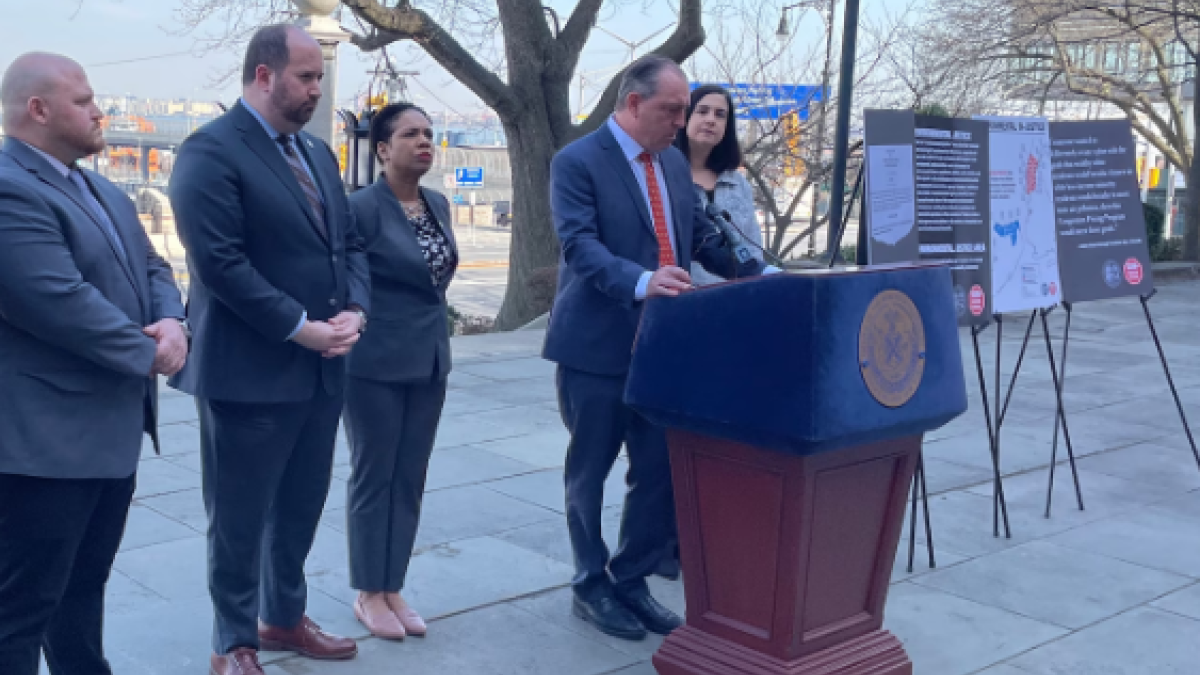MTA’s congestion pricing is ‘borough discrimination,’ Staten Island elected officials say

STATEN ISLAND, N.Y. -- The ripple effects of congestion pricing will disproportionately affect lower-income neighborhoods, according to Staten Island’s elected officials.
At a press conference on Thursday at Borough Hall, Borough President Vito Fossella presented information from New York City’s Open Data portal showing that congestion pricing will decrease the quality of life in lower-income areas, especially along Staten Island’s North Shore.
The borough president was flanked by Rep. Nicole Malliotakis (R-Staten Island/South Brooklyn), Councilmember Kamillah Hanks (D-North Shore) and Councilmember David Carr (R-Mid-Island). They were also joined by representatives from the offices of State Sen. Jessica Scarcella-Spanton (D-North Shore/South Brooklyn), Assemblymember Michael Tannousis (R-East Shore/South Brooklyn), Assemblymember Michael Reilly (R-South Shore), Assemblymember Sam Pirozzolo (R-Mid-Island) and Councilmember Joseph Borelli (R-South Shore).
“We’ve been saying this for quite some time — that this plan would hurt Staten Island,” said Malliotakis. “And now to see that, predominately, the individuals that will be hurt by congestion pricing are minorities really is hypocrisy on the part of those who are saying they want social justice across the city of New York.”
The statistics they presented compared the average income and racial makeup of Manhattan ZIP codes in the Central Business District — from the southern tip up to 60th Street — to the demographics of the North Shore, from St.George to Mariners Harbor.
Their takeaway is that the parts of Manhattan that will benefit from the reduced traffic and cleaner air brought on by congestion pricing are wealthier and whiter than the outer borough communities, which people will use to skirt the proposed toll.
“If anyone wanted to deliberately create a plan that wealthy white residents would breathe cleaner air while low-income minority residents would be left in more toxic air pollution, then this congestion program would meet those goals,” said Fossella
In a statement responding to these claims, MTA spokesperson Aaron Donovan said: “If BP Fossella truly cared about low-income New Yorkers — 98% of whom rely on public transportation — he would be a strong supporter of congestion pricing.”
Hanks, who is just one of the Island’s Democrats opposing congestion pricing, stated: “As the borough president said, it’s not about Republicans and Democrats. I always say we’re only registered Staten Islanders. And when you live in Staten Island, you bear the brunt.”
“We’ve had enough of borough discrimination,” she added after the press conference.
LEGAL CHALLENGES
The information presented at Borough Hall echoes similar claims made by Fossella and the United Federation of Teachers (UFT) in a lawsuit designed to stop congestion pricing.
The suit, which is publicly available online, claims that the plan “would not eliminate air and noise pollution and traffic, but would simply shift pollution and traffic to Staten Island, the Bronx, Upper Manhattan, and Northern New Jersey.”
After the lawsuit was filed, most of Staten Island’s other elected officials joined as co-plaintiffs.
The project’s environmental assessment noted that congestion pricing will likely result in additional traffic and pollution on Staten Island as vehicles try to avoid the new toll.
The lawsuit calls for the MTA to conduct a full Environmental Impact Statement (EIS) for what would be the nation’s first congestion pricing program, stating that the abbreviated Environmental Assessment (EA) conducted was “rushed and hurried,” an argument that local elected officials have repeatedly raised.
THE BOTTOM LINE
If approved, the $15 toll, which would be capped at once per day, would be in effect on weekdays from 5 a.m. to 9 p.m. and on weekends from 9 a.m. to 9 p.m. The toll would be $3.75 during overnight hours, a 75% discount on the standard $15 toll.
Drivers who enter the CBD through the Queens-Midtown, Hugh L. Carey, Holland and Lincoln tunnels would receive a $5 credit, bringing their toll rate down to $10.
Trucks would be charged a higher toll than passenger vehicles because they contribute more heavily to congestion and roadway deterioration.
Small trucks would be charged $24, while larger trucks would be charged $36. If they enter the zone at one of the aforementioned tunnels, these vehicles will receive $12 and $20 crossing credits, respectively.
Drivers who enter Manhattan via the George Washington Bridge will not receive a credit, something New Jersey officials have have tried to stop.
No additional credits would be offered to Staten Islanders, who cross the Verrazzano-Narrows Bridge to enter Brooklyn before moving to Manhattan.